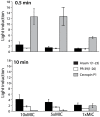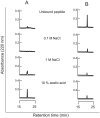Structure-activity relationships of the antimicrobial peptide arasin 1 - and mode of action studies of the N-terminal, proline-rich region
- PMID: 23326415
- PMCID: PMC3543460
- DOI: 10.1371/journal.pone.0053326
Structure-activity relationships of the antimicrobial peptide arasin 1 - and mode of action studies of the N-terminal, proline-rich region
Abstract
Arasin 1 is a 37 amino acid long proline-rich antimicrobial peptide isolated from the spider crab, Hyas araneus. In this work the active region of arasin 1 was identified through structure-activity studies using different peptide fragments derived from the arasin 1 sequence. The pharmacophore was found to be located in the proline/arginine-rich NH(2) terminus of the peptide and the fragment arasin 1(1-23) was almost equally active to the full length peptide. Arasin 1 and its active fragment arasin 1(1-23) were shown to be non-toxic to human red blood cells and arasin 1(1-23) was able to bind chitin, a component of fungal cell walls and the crustacean shell. The mode of action of the fully active N-terminal arasin 1(1-23) was explored through killing kinetic and membrane permeabilization studies. At the minimal inhibitory concentration (MIC), arasin 1(1-23) was not bactericidal and had no membrane disruptive effect. In contrast, at concentrations of 5×MIC and above it was bactericidal and interfered with membrane integrity. We conclude that arasin 1(1-23) has a different mode of action than lytic peptides, like cecropin P1. Thus, we suggest a dual mode of action for arasin 1(1-23) involving membrane disruption at peptide concentrations above MIC, and an alternative mechanism of action, possibly involving intracellular targets, at MIC.
Conflict of interest statement
Figures







References
-
- Hancock RE, Diamond G (2000) The role of cationic antimicrobial peptides in innate host defences. Trends Microbiol 8: 402–410. - PubMed
-
- Shai Y (1999) Mechanism of the binding, insertion and destabilization of phospholipid bilayer membranes by alpha-helical antimicrobial and cell non-selective membrane-lytic peptides. Biochim Biophys Acta 1462: 55–70. - PubMed
-
- Shai Y (2002) Mode of action of membrane active antimicrobial peptides. Biopolymers 66: 236–248. - PubMed
Publication types
MeSH terms
Substances
LinkOut - more resources
Full Text Sources
Other Literature Sources
Molecular Biology Databases

